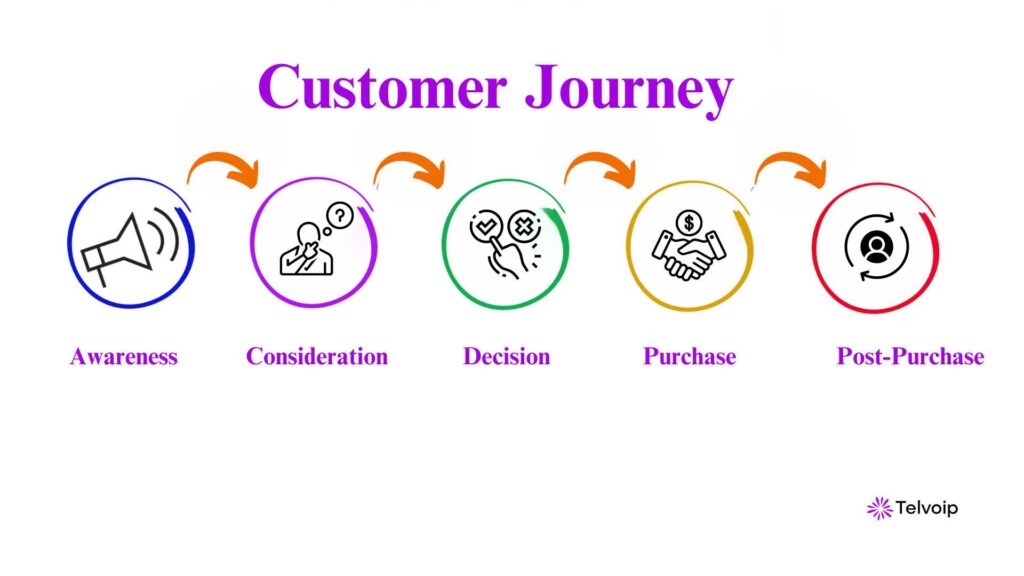Table of Contents
ToggleIntroduction
Understanding the customer journey is crucial for businesses to provide exceptional customer experiences and build long-lasting relationships. The customer journey encompasses all the interactions a customer has with a company, from initial awareness to post-purchase support. Contact centers play a vital role in this journey, serving as the primary point of interaction for customers seeking assistance, information, or resolution to their issues.
By analyzing the customer journey and optimizing the contact center experience, businesses can identify and address areas of concern, streamline processes, and deliver personalized support that meets the changing needs of their customers. Embracing this approach leads to increased customer satisfaction, stronger loyalty, advocacy, and contributes to business growth.
What is a Customer Journey?
The customer journey is a comprehensive framework that maps out the various interactions a customer has with a company throughout their relationship. It encompasses the entire lifecycle, from initial awareness and research to the purchase decision, product usage, and post-purchase support. Each step in the journey presents an opportunity for the company to create a positive experience that builds trust, loyalty, and advocacy.
However, if any stage falls short, it can negatively impact the customer’s perception and likelihood of continuing their relationship with the brand. Through comprehensive understanding and optimization of the customer journey, businesses can identify opportunities for enhancement, streamline operations, and provide outstanding experiences that align with the dynamic demands and expectations of their customers.
Stages of the Customer Journey

- Awareness: This is the initial stage where the customer becomes aware of a need or problem they want to solve. They may encounter the company’s products or services through various marketing channels, such as advertising, word-of-mouth, or online searches. At this stage, the company’s goal is to capture the customer’s attention and create a positive first impression.
- Consideration: Once the customer is aware of their need, they begin to research and evaluate potential solutions. They may compare products, read reviews, and seek recommendations from friends or experts. The company’s role is to provide informative and engaging content that helps the customer make an informed decision.
- Decision: After weighing their options, the customer reaches the decision stage where they choose a product or service that best meets their needs. The company should make the purchasing process as smooth and convenient as possible, offering clear pricing, secure payment options, and transparent shipping and delivery information.
- Purchase: This is the moment when the customer completes the transaction and becomes a paying customer. The company should ensure that the purchase experience is seamless, with accurate order processing, timely delivery, and clear communication throughout the process.
- Post-Purchase: After the purchase, the customer enters the post-purchase stage, where they begin using the product or service. If they encounter any issues or have additional questions, they may reach out to the company’s customer support. The company should provide responsive and helpful support, ensuring that the customer’s needs are met and that they are satisfied with their purchase. This stage is crucial for building long-term customer loyalty and encouraging continual sales.
Role of Contact Centers in the Customer Journey
- Initial Contact and Awareness
Contact centers play a vital role in the initial contact and awareness stage of the customer journey. As the primary point of interaction for many customers, contact center agents are often the first representatives of the company that customers engage with. During this stage, agents provide crucial information and support that helps customers move from mere awareness of the company to actively considering its products or services.
By offering knowledgeable and helpful responses to customer inquiries, addressing concerns, and guiding them through the initial stages of their journey, contact center agents can create a positive first impression and lay the foundation for a successful customer-company relationship. The quality of the initial contact can significantly influence the customer’s perception of the company and their likelihood of progressing to the next stage of the journey.
- Consideration and Engagement
During the consideration and engagement stage of the customer journey, contact center agents play a crucial role in helping customers make informed decisions. By providing detailed information, answering questions, and offering personalized suggestions, agents can guide customers through the decision-making process.
This level of engagement helps build trust and credibility, as customers appreciate the time and effort put into understanding their unique needs and preferences. When agents take the time to listen, ask probing questions, and offer tailored recommendations, it demonstrates the company’s commitment to customer satisfaction. As a result, customers feel more confident in their decision and are more likely to move forward with a purchase.
The consideration and engagement stage is a critical juncture where contact center agents can make a significant impact on the customer’s perception of the company and their likelihood of becoming a loyal customer.
- Decision and Purchase
As customers reach the decision and purchase stage of their journey, contact center agents play a vital role in facilitating a seamless and positive experience. During this critical phase, agents can assist with the transaction process, ensuring that customers have all the necessary information and support to complete their purchase with confidence.
By addressing any concerns or questions that may arise, agents can help alleviate any hesitation or uncertainty, ultimately leading to a successful transaction. Furthermore, agents can enhance the customer’s experience by suggesting complementary products or services that align with the customer’s needs, adding value to the overall purchase.
This proactive approach demonstrates the company’s commitment to providing a personalized and tailored experience, fostering customer loyalty and increasing the likelihood of repeat business.
- Post-Purchase Support and Retention
The post-purchase stage is a crucial phase in the customer journey, where contact center agents play a vital role in providing support, resolving issues, and ensuring customer satisfaction. When customers encounter problems or have questions after making a purchase, they often turn to contact centers for assistance. By offering prompt, knowledgeable, and empathetic support, agents can help alleviate the customer’s concerns and demonstrate the company’s commitment to their well-being.
Effective post-purchase support not only resolves immediate issues but also fosters long-term customer loyalty and retention. When customers feel valued and cared for, they are more likely to continue doing business with the company and recommend its products or services to others. Contact center agents who go above and beyond to address customer needs and provide exceptional service can significantly impact the customer’s overall perception of the company and their likelihood of becoming a loyal advocate.
Challenges in the Customer Journey
- Communication Breakdowns
Miscommunications in contact centers can cause frustration for customers, leading to confusion and delays. To prevent breakdowns, contact centers should prioritize training agents in effective communication skills, maintain accurate knowledge, and establish clear protocols. This culture can build stronger customer relationships, resolve issues efficiently, and drive long-term loyalty.
- Lack of Integration
The inability to integrate various systems and tools in contact centers can significantly impact customer experience. This can lead to fragmented and frustrating experiences, with agents struggling to access complete customer information and longer wait times. To improve customer experience, contact centers should prioritize integrating CRM systems, communication channels, and support tools, enabling agents to understand customer context, provide personalized support, and track interactions.
- Data Privacy Concerns
Contact centers must prioritize data privacy and security measures to protect customer information from cyber threats and breaches. Adherence to strict privacy regulations mandates stringent security controls, encryption, and secure storage practices. Agents must undergo comprehensive training on data privacy protocols.
Conclusion
In conclusion, understanding the customer journey in contact centers is essential for delivering outstanding customer service and fostering long-term relationships. By mapping out each stage of the journey and optimizing the contact center experience, businesses can identify challenges, streamline processes, and offer personalized support that meets the evolving needs of their customers. Incorporating Telvoip into this strategy can significantly enhance these efforts. Telvoip’s advanced solutions ensure seamless and efficient interactions, providing customers with prompt and accurate support.
A well-optimized customer journey, supported by Telvoip, not only enhances satisfaction but also drives loyalty, advocacy, and business growth. As customer expectations continue to evolve, businesses must remain adaptable and proactive in addressing challenges, integrating new technologies, and prioritizing data privacy. In doing this, businesses can guarantee a smooth and positive customer experience, ultimately resulting in consistent success and growth.








